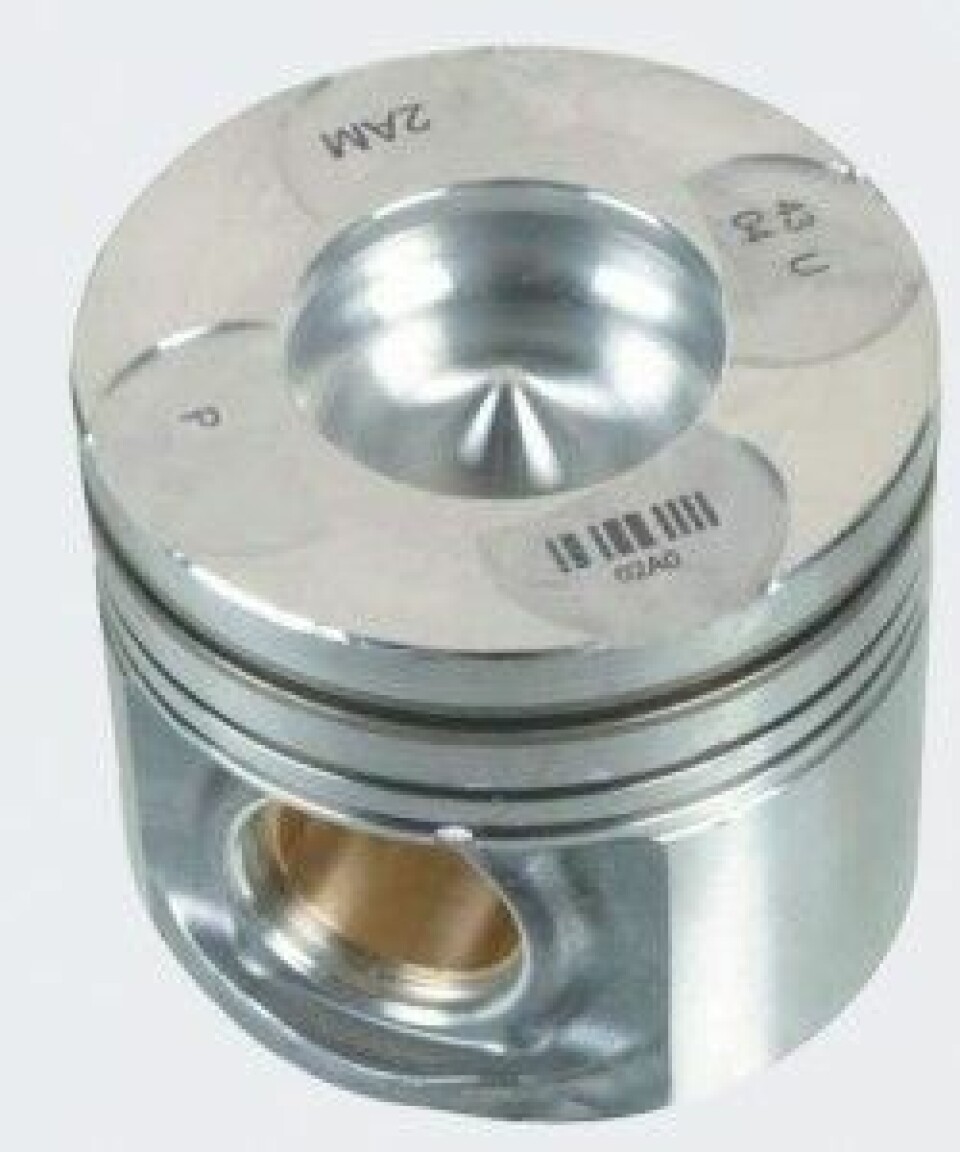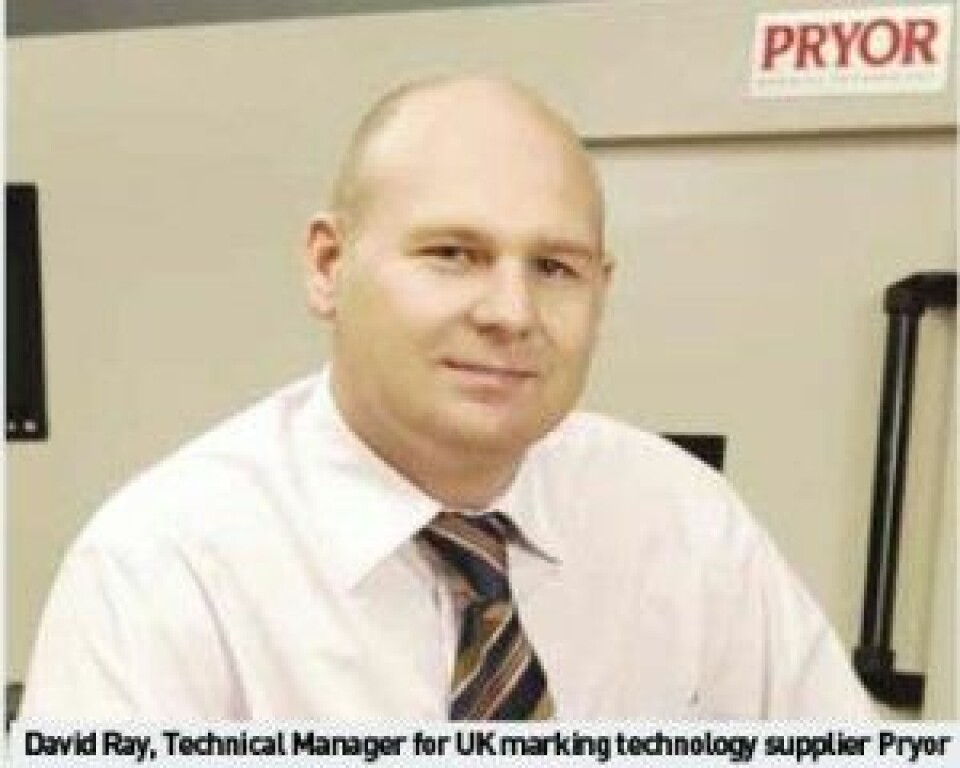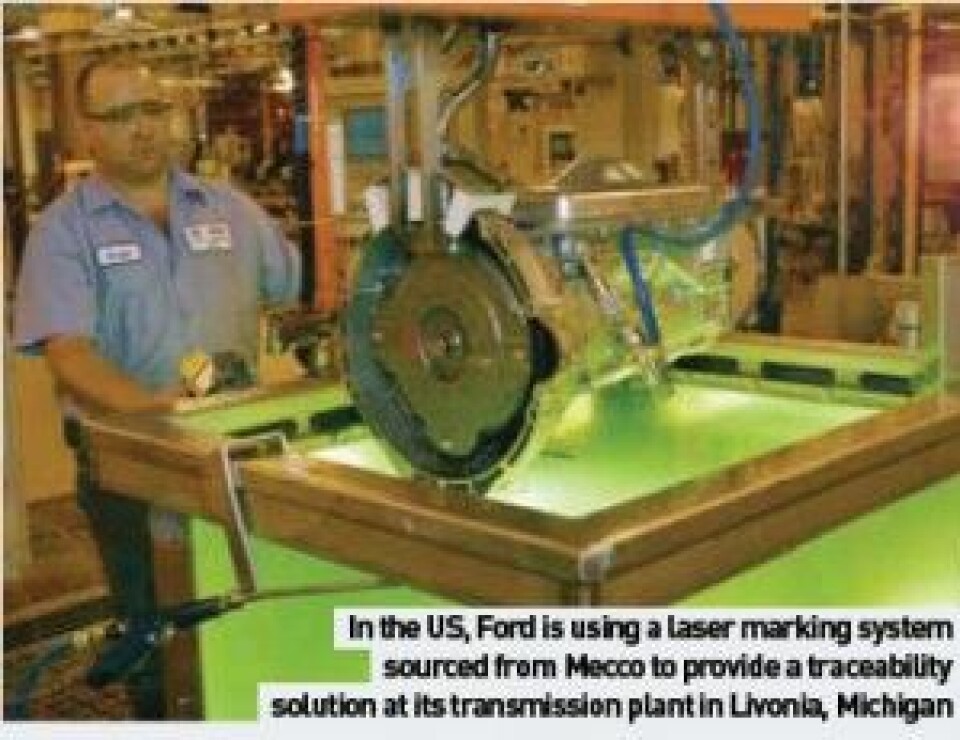Makers mark
While manufacturers have long seen the light when it comes to lasers, some are still in the dark when it comes to their use in parts identification. AMS finds an industry hiding its light under a bushel
Featured in all digital media systems, across many areas of modern medicine and in precision cutting and welding tools, the ubiquitous use of lasers means they are no longer considered anything out of the ordinary.
But it is this pervasive application by manufacturers, and most notably carmakers, that has been enhancing the assembly process at all stages. Now, yet another new use for lasers has come to light: the indelible marking of individual glass, metal and plastic car parts. As often happens, it is the suppliers of a technology rather than the end users that prove more willing to talk about the application of new products and techniques.
David Ray, technical manager for UK marking technology supplier Pryor, is the one those suppliers and he confirms that lasers are beginning to make some headway in the automotive sector as marking tools. According to Ray, Pryor has been providing ‘impact-based’ marking technologies, such as dot peening, to the automotive industry for the last 20 years. A decade ago, a stylus-based scribing technology was introduced, with lasers only recently beginning to quite literally make their mark in the industry.
Ray explains that the automotive sector has traditionally displayed a preference for lower-cost, higher-speed marking systems, defaulting to robustness and reliability as preferred attributes. Up until five years ago, he estimates, lasers simply could not fulfil those requirements, and though they were not unknown in the sector before then, they were extremely rare. A number of factors have come together to make lasers more attractive to the automotive sector, says Ray, one of which is the recognised value of marking beyond the basic requirement of applying a VIN number to a completed vehicle.

Automated identification
The international motor industry does not currently have a standardised system to assist in parts tracking and traceability. But some carmakers have come to understand that an appropriate mix of standardisation and automated identification (AID) could generate significant efficiency benefits, both in internal parts tracking and stemming the trade of counterfeit or stolen vehicle parts. In relation to the latter, AID is of particular benefit for identifying safetycritical parts, such as braking or steering components. Unique identification codes can also benefit parts suppliers. Should a fault be found within a particular batch, the ability to pinpoint the affected product through unique identification codes could avoid a large scale, blanket recall of parts or worse, finished vehicles. Instead, a precisely targeted campaign could identify the affected products, minimising cost and the negative publicity associated with such events.
Similarly, a secure and reliable part identification system would assist in eliminating false warranty claims. A vehicle repairer would be unable to make a claim using parts that the manufacturer’s records would already show as having been removed from an older vehicle already out of warranty. The attempted deception would be immediately detected. Increasing choice It is only recently that lasers have offered the ability to create these unique identifiers. Now there are two choices when considering an industrial laser application: CO2 lasers, in which carbon dioxide gas forms anything from 10 to 20 per cent of the filling of the discharge tube; and Nd: YAG diodepumped counterparts.
Although both have their individual benefits, Ray believes that it is Nd: YAG lasers that have become the more popular choice in discrete manufacturing applications, due to the advantages they offer in terms of beam consistency and quality, as well as longevity of service. An Nd: YAG device, he says, can usually be relied to provide “10-15,000 hours” of service before the diode is likely to need replacing. There is, though, a new type of laser device now available: the fibre laser. These are quite similar to Nd: YAG devices in regard to their utility, says Ray, but offer significant price savings. A complete Class 1 Nd: YAG laser installation, which could demand an investment of between £40,000-£50,000 ($78,000-$97,000), might only cost half as much when specified with a fibre equivalent. Though still appreciably more expensive than abrasive counterparts, available for between £4,000-£15,000 ($8,000-$29,000) depending on their complexity, the narrowing of the price gap means that some of the specific advantages lasers can bring to marking applications may be viewed as worth the extra expense.

Aesthetic application
According to Ray, a key advantage of lasers in comparison with abrasive systems is the overall quality of the mark. Far superior in regards to accuracy, lasers are able to create a ‘data matrix’ mark, a concise 2D inscription that incorporates sufficient information to give each marked part a unique identity verifiable with AID. Further, the precision of laser marking makes it suitable for applying identifying information in customer-facing positions; in other words, where vehicle owners can easily see the markings, but the markings themselves do not detract from any aesthetic appeal. Rather ironically, as Ray concedes, prime candidates for such marking are windscreens, but the longer wavelengths of laser light produced by fibre lasers (typically 1,064 nanometres) make them less suitable for marking glass and plastics than metals. Older Nd: YAG lasers which have a wavelength of 532 nanometres, with a low power setting, are more appropriate for glass and plastic.
Flexible installation
Like most technology suppliers, Pryor is reticent about naming actual clients, but the company is currently finalizing a deal to install a laser-marking system at an automotive customers’ headlamp assembly plants in the UK and Poland. According to Ray, the actual marks will be made on black plastic, but more importantly, it is the flexibility of the system – its ability to support a wide degree of product variety – that is most appealing. “All the different angles the lights are set to, multiplied by two for left- and right-hand versions” can be catered for says Ray.
Perhaps the most intriguing aspect of the installation, however, is that the laser-marking system will also have a secondary role, more in line with the Hollywood stereotype of lasers as destructive devices. The whole installation will have 12 sensors carrying out work piece inspections. One of them will be programmed to order a ramp up in laser power to burn a hole through any headlamp assembly identified as failing quality control. The unit involved will then automatically fail a water-tightness assessment at another test station further down the line, where it will be removed and scrapped.
Desktop systems
Meanwhile, further confirmation that laser marking is starting to establish itself is provided by Electrox, based in Letchworth, UK. A member of the 600 Group machine tool conglomerate, Director and General Manager Howard Moore confirms that the company has around 2,000 individual laser units installed in automotiverelated companies worldwide, with future growth in the segment expected to be between 10 and 12 per cent per year. With the market evenly split between units integrated into automated production lines and desktop systems, where loading and unloading continues to be a manual task, Moore surprisingly anticipates the sale of desktop systems to keep pace with their in-line counterparts for the forseeable future.
Moore goes on to explain that the typical cost for a desktop unit, physically taking the form of a 600x600mm box, would average “less than £20,000” ($40,000), whereas an in-line system could be more than twice that amount. Pure production volumes, he went on to confirm, are the decisive factor in determining which is the appropriate choice, there being no differences in terms of the type, size or quality of mark or the type of materials that can be treated with either setup. Desktop systems are better suited – if only from a financial perspective – for applications where volumes reach a maximum of a few hundred units per day. More than that and a manufacturer would be obliged to install an in-line system.

Equally importantly, there are no significant issues or differences in terms of training of operators, health and safety, or running costs between the two choices. More says that as far as training is concerned, a single day’s instruction would be sufficient to bring someone with an existing familiarity of shopfloor industrial operations up to speed. As for safety, he is similarly matter-of-fact. A well-installed light-proof housing, itself an entirely unremarkable piece of equipment, ensures that laser operations present no operator hazard. Moore also points out that where similar equipment of only three or four years ago required supplementary cooling equipment, the latest laser installations have done away with such setups. An industrial laser, he remarks, will now generate no more heat “than a couple of 100W light bulbs”.
The need for Moore to make that point identifies a basic lack of knowledge in the industry as to what lasers can do, combined with the persisting idea that lasers represent an expensive, overly-complex alternative to more established technologies. Moore estimates that only 40 per cent of potential users of the technology across all industry sectors actually employ it, the difference between those that do and those that don’t often nothing more than a willingness to innovate.

Marked improvement
One major carmaker that has assimilated laser marking is Ford. According to Steve Speed, Senior Engineer at the company’s engine prototyping facility in Dunton, UK, it has been 18 months since Nd: YAG marking from Electrox was installed. Originally planned for the marking of tooling used in the production of cylinder heads and blocks, such was the success of the installation that a further desktop system has been purchased. Speed says that some 300 fixtures were involved in that first venture into laser marking, each of them with 20 separate components made from case-hardened steel, all of which required marking.
Up until the installation, the facility was using manual engraving to mark its components, but as Speed says, once engineers had encountered laser marking at an exhibition, they were immediately impressed by the marking quality. With positive feedback from the shopfloor, Speed announces that, “everything that goes through here that has a flat surface now gets a laser
mark.” Indeed, such is the success of the technique, that Ford is hoping to add radial marking capability in the near future, enabling laser marking of curved surfaces. In the US, Ford is using a laser marking system sourced from Mecco to provide a traceability solution at its transmission plant in Livonia, Michigan. According to Frank Maslar of Ford Advanced Manufacturing Technology Group, “Ford will utilise this tracking information to maintain process control.”
Marking transmission casings with both 2D data matrix and alpha-numeric identifiers, information that is read at predetermined points along the production line, the Mecco system employs a 20W fibre laser. Capable of providing more than 30,000 hours of operation at a speed of 3,000mm/sec, which equates to 250 characters-per-second over a surface of 25 square inches, the system can operate without a safety enclosure, reducing the required floor space.
Another German-owned user of laser technology is Continental Automotive, manufacturers of braking systems, telematics and electric drive units. The company has been using lasers since 1992 for marking the valves used in anti-lock braking systems. According to the company, the primary factor for choosing laser technology was simply the small size of the units. As ABS valves are too small and sensitive for adhesive labelling or any mechanical, contact based alternative, laser marking was the only choice. Described as being “fast, flexible and soft”, the company plans to extend its laser marking programme to cover all valve products and housings.
Light applications for lasers
Hella, the German lighting and electronics systems supplier, has a sustained track record of using laser marking. In fact, according to Dr Petrik Lange, head of manufacturing technologies for Hella’s Electronics Business Division, laser markings have been added to the housings of electronic assemblies since the 1990s. And laser-marking technology continues to be adopted within the company. As Lange explains, it was less than two years ago that Hella adopted the technology for the application of identification codes to individual printed circuit boards (PCBs).
In fact, according to Lange, Hella is now using lasermarking technology at production plants in Germany, the US, Romania and, most recently, China. No exact figure is available, but he estimates over one million parts per year are marked in this way. Moreover, from Hella’s perspective, the technology has proven a great success, with its usage likely to be extended. A number of different factors have come together in recent years to drive Hella towards laser marking for PCBs, though underpinning them all is an increased demand for complete product traceability, with laser marking outperforming inkjet printing or adhesive labelling.
In contrast to the intermittent take-up of laser marking in auto manufacturing, the technology is now well established in the aerospace sector. According to Kim Ward, Chief Executive of aerospace components manufacturer Hampson Group, based in Dudley, UK, the technique is now commonplace in all-new projects. Ward confi rms that driving the adoption of the technology in the aerospace sector is the demand for unique, through-life part identification and traceability outlined in the Spec 2000 set of standards administered by the US Air Transport Association of America. To briefly summarise, this means that every critical component used in an aircraft must bear a unique and indelible identification mark in the form of either a bar or data matrix code.
Though laser technology is not specifically named as the means by which this should be accomplished, it is the solution that aerospace manufacturers now habitually use due to the clear advantages offered over any other methods. Ward says that over the last five years the speed of laser technology and a sharp reduction in cost have combined to create the technique’s dominant position.
As such, Hampson now uses laser marking on all parts manufactured for new aircraft projects, with the range of materials involved including aluminium, titanium and various nickel-based alloys. In fact, says Ward, the only circumstance in which any aerospace supplier would now choose not to use laser marking would be if they were supplying parts for older aircraft. In such circumstances, he explains, a change in the marking technique would constitute a change in the specifi cation and require the production and approval of a new set of drawings.
SMD applications
Another major advantage of laser marking is the ease with which it can be integrated into automated procedures on surface mount device (SMD) production lines. Lange notes that laser systems can easily store a number of different marking routines, switching between them quickly and reliably. In other words, they are an ideal tool in cases where high production volumes need to be reconciled with the need to manufacture parts in dissimilar batches. Lange explains: “Some of our SMD lines make multiple products, and lasers are appropriate when there is a rapidly alternating product variety on the line.” In that sense, the use of lasers fits in with the broader strategy of investing in flexible, automated PCB production facilities that Hella has adopted as a way of responding to current market demands. But there are also other, more immediate factors. One of them, Lange notes, is that the cycle time for an individual labelling operation is appreciably faster for a laser than any rival technique. Another, particularly important for components the size of a PCB, is that lasers allow for the application of much smaller identification marks than labelling.
A further issue, one driven by environmental considerations, is the increasing use of lead-free soldering techniques. Lange explains that such operations take place at a much higher temperature, approximately 40C greater than conventional soldering. That temperature difference can destroy pre-applied plastic labels, unless more specialised and expensive materials are used. Laser marks, however, are unaffected.
Potential drawbacks
Despite the benefits, there are also some caveats related to the fact that laser marking is not just a simple plugin technique. One potential drawback is the need for appropriately skilled personnel, though as mentioned, a person with a suitable background would take less time to familiarise themselves with the technology. Another is that it likely requires a supplementary investment in automated reading technology. Previous equipment of that sort, bought for use with hardcopy labels, may not necessarily be able to recognise laser inscriptions and even the type and intensity of the lighting used in the general factory environment may have to be changed. What this means is that the total cost of implementing a total lasermarking solution goes further than the purchase of the equipment itself.
However, balancing the arguments for and against laser marking, Lange pronounces himself and Hella satisfied with the technology, which includes both CO2 and Nd: YAG lasers. “It is a stable, successful technology,” he sums up. And with the inception of fibre-laser technology, he is confident the company’s use of laser marking will increase. Considering the dated alternatives, laser marking is clearly a technology whose time has come. Compared to adhesive or abrasive alternatives, it offers unrivalled precision and flexibility, particularly when dealing with small or fragile items, or products with extreme temperature considerations. The lack of freely available, impartial information on the technology is detrimental to both suppliers of the equipment and manufacturers, in terms of production security and quality assurance. With most user insight locked behind the walls of commercial confidentiality, the availability of laser marking appears to be one of the best-kept secrets in the manufacturing world.


